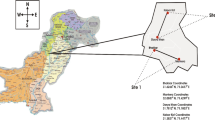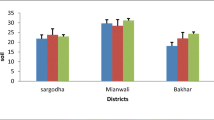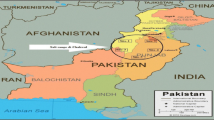Summary
The trace element status of crossbred Friesian × zebu (Boran) and local zebu cattle in the Selale highlands of Ethiopia was evaluated during the rainy and dry seasons of 1989 and 1990 in terms of the trace element content of soils, feeds, blood plasma and faeces on 25 randomly selected farms. Liver samples from animals of local breeds from a slaughter house were collected during the rainy and dry seasons of 1990 and analysed.
Soil Fe and Mn were found to be high. Iron contents of all feeds were extremely high and Mn contents were higher than the dietary requirement. A large proportion of feed samples were deficient in Cu and zinc. There were wide variations in the concentrations of these elements among the soil and feed samples.
Blood plasma Fe (P<0·001) and Cu (P<0·01) values differed significantly between the years. Plasma samples collected during 1990 contained lower mean Cu than 1989. The effect of season was statistically significant (P<0·001) for all the trace elements. More than half of the animals were found to have low plasma Cu and Zn during the rainy season. Due to lack of any correlations between soil, pasture and blood plasma it is suggested that analyses of soils and pasture are not reliable for assessing the Fe, Cu and Zn status of grazing cattle in the highlands. Analyses of liver and blood appear to provide better indices.
Résumé
Les teneurs en oligo éléments des croisements Frison x Boran et zébu locaux dans les Hautes Terres du Selale éthiopien ont été estimées durant les saisons sèches et humides des années 1989 et 1990 en termes de contenu spécifique des sols, des aliments du bétail, du plasma sanguin et des fèces sur 25 fermes sélectionnées au hasard. Des prélèvements de foie sur des animaux de race locale ont été effectués à l'abattoir pendant les saisons sèches et humides de 1990 en vue de leur analyse. Des taux éléves ont été trouvés pour le fer et le magnésium du sol. Les teneurs en fer de tous les aliments étaient extrêmement élevées et celles en magnésium étaient plus élevées que les besoins alimentaires. Une forte proportion des échantillons d'aliments étaient carencés en cuivre et en zinc. Les variations des concentrations de ces élements dans les prélèvements de sols et d'aliments se situaient dans une large échelle. Les valeurs du fer plasmatique sanguin et celles du cuivre différaient de façon significative selon les années (P<0,001 etP<0,01 respectivement). Les prélèvements de plasma collectés en 1990 contenaient en moyenne moins de Cu qu'en 1989. L'effet de la saison etait statistiquement significatif pour (P<0,001 pour tous les oligo éléments. Pour plus de la moitié des animaux, les teneurs plasmatiques en Cu et Zn étaient peu élevées pendant la saison des pluies. En raison du manque total de corrélations entre le sol, le pâturage et le plasma sanguin, il est à penser que les analyses des sols et des pâturages ne sont pas fiables pour la détermination des teneurs en fer, cuivre et zinc du bétail au pâturage dans les Hautes Terres. Les analyses du foie et du sang apportent des indications plus satisfaisantes.
Resumen
Se evaluó el contenido de microelementos en suelos, alimentos, plasma sanguíneo y heces en 25 fincas escogidas al azar. El ganado utilizado como unidades experimentales fueron cruces de Friesian × Cebú (Boran) y ganado Cebú local, en las tierras altas de Selale en Etiopía; la evaluacion tuvo lugar durante las estaciones lluviosas y secas de 1989 y 1990. Se analizaron también muestras de hígado tomadas de ganado en el matadero durante la estación lluviosa y seca de 1990.
El Fe y Mn se encontraron altos en los suelos. El contenido de hierro de todos los suelos fue extremadamente alto, como también el contenido de Mn. Sin embargo, una gran proporción de alimentos fue pobre en Cu y Zinc. Estos elementos variaron ampliamente en el suelo y muestras de alimentos.
Los valores de Fe plasmático (P<0·001) y de Cu (P<0·01) difirieron ampliamente entre años. Las muestras plasmáticas colectadas durante 1990 contuvieron menos Cu que en 1989. El efecto de la estación fue significativa estadísticamente (P<0·001) para todos los elementos traza.
Más de la mitad de los animales se encontraron con niveles de Cu y Zn plasmáticos bajos durante la estación lluviosa. Debido a la carencia de correlación entre suelo, pasturas y plasma sanguíneo, se sugiere que el análisis de pasto y suelo no son confiables para estudiar valores de Fe, Cu y Zn en ganado en pastoreo en las tierras altas de Etiopía. Aparentemente el análisis de hígado y sangre provee mejores índices.
Similar content being viewed by others
References
Abrams, E., Lassiter, J. W., Miller, W. J., Neathery, M. W., Gentry, R. P. &Blackmon, D. M. (1977). Effect of normal and high Mn diets on the role of bile in Mn metabolism of calves.Journal of Animal Science,45, 1108–1113.
Campbell, A. G., Coup, M. R., Bishop, W. H. &Wright, D. E. (1974). Effect of elevated iron intake on the copper status of grazing cattle.New Zealand Journal of Agricultural Research,17, 393.
Faye, B., Grillet, C. &Tessema, A. (1986). Trace mineral contents in forages and plasma of domesticated ruminants in Ethiopia.Revue d'Élevage et de Médecine Vétérinaire de Pays Tropicaux,39, 227–237.
Fick, K. R., McDowell, L. R., Miles, P. H., Wilkinson, N. S., Funk, J. D. &Conrad, J. H. (1979). Methods of mineral analysis for plant and animal tissues. Second ed. Animal Science Department, University of Florida, Gainesville, Florida, USA.
Gomide, J. A., Noller, C. H., Mott, G. O., Conrad, J. A. &Hill, D. L. (1969). Mineral composition of six tropical grasses as influenced by plant age and nitrogen fertilization.Agronomy Journal,61, 116.
Hartmans, J. (1970). Trace Elements Metabolism in Animals. Proceedings: WAAP/IBP Int. Symp: 1969. (Cited in McDowell, 1985). pp 441–445.
Healy, W. B. (1968). Ingestion of soil by dairy cows.New Zealand Journal of Agricultural Research,11, 487–499.
Humphries, W. R., Phillippo, M., Young, B. W. &Bremner, I. (1983). The influence of dietary Fe and Mo on Cu metabolism in calves.British Journal of Nutrition,49, 77.
Kabaija, E. &Little, D. A. (1988). Nutrient quality of forages in Ethiopia with particular reference to mineral elements. Proceedings of the 3rd workshop held at the International Conference Centre, Arusha, Tanzania. Pastures Network for Eastern and Southern Africa (Panesa). International Livestock Centre for Africa (ILCA), Addis Ababa. pp 423–427.
Khalili, M., Lindgren, E. &Varvikko, T. (1993). A survey of mineral status of soils, feeds and cattle in the Selale Ethiopian highlands: I. Macro elements.Tropical Animal Health and Production,25, 162–172.
Kiatoko, M., McDowell, L. R., Bertrand, J. E., Chapman, H. L., Pate, F. M., Martin, F. G. &Conrad, J. H. (1982). Evaluating the nutritional status of beef cattle herds from four soil order regions of Florida. I. Macroelements, protein, carotene, vitamins A and E, hemoglobin and hematocrit.Journal of Animal Science,1, 28–37.
Lindsay, W. L. &Norvell, W. A. (1969). Equilibrium relationships of Zn2+, Fe3+, Ca2+ and H+ with EDTA and DTPA in soils.Proceedings of the Soil Science Society of America,33, 62–68.
Long, M. I. E., Thornton, D. D., Ndyanabo, W. K., Marchall, B. &Ssekaalo, H. (1970). The mineral status of dairy farms in the parts of Buganda and Busoga bordering Lake Victoria, Uganda.Tropical Agriculture (Trinidad),47, 37–50.
Long, M. I. E., Marshall, B., Ndyanabo, W. K. &Thornton, D. D. (1972). The mineral status of dairy farms in eastern Uganda. Nitrogen and mineral content of grasses and some mineral contents of bovine plasma.Tropical Agriculture (Trinidad),49, 227–234.
Mahmoud, O. M., El Samani, F., Bakheit, A. O. &Hassan, M. A. (1983). Zinc deficiency in Sudanese desert sheep.Journal of Comparative Pathology,93, 591–595.
McDowell, L. R. (1985).Nutrition of Grazing Ruminants in Warm Climates. (Ed. L. R. McDowell). Academic Press, Orlando, Florida.
Mtimuni, J. P. (1982). Identification of mineral deficiencies in soil, plant and animal tissues as constraints to cattle production in Malawi. Ph.D thesis. University of Florida, Department of Animal Science, Gainesville, Florida, USA.
NRC (1989). National Research Council. Nutrient requirements of dairy cattle. Sixth revised edition. National Academy Press. Washington DC.
Prabowo, A., Salam, R. McDowell, L. R., Wilkinson, N. S. &Kawashima, T. (1989). Effects of soil ingestion and mineral supplementation on performance and mineral utilization in lambs. Proceedings of International Meeting on Mineral Nutrition and Mineral Requirements in Ruminants. Kyoto, Japan, 1989.
Roeder, P. L. (1980). Effects of copper and cobalt treatment of cattle in the Ethiopian Rift valley.Tropical Animal Health and Production,12, 63–68.
Sillanpää, M. (1982). Micronutrients and the nutrient status of soils: a global study. FAO Soil Bulletin 48.
Suttle, N. F. (1983). Assessment of the mineral and trace element status of feeds. Proceedings of the Second Symposium of the International Network of Feed Information Centres. Commonwealth Agricultural Bureaux. pp 211–237.
Tejada, R. (1984). Evaluation of the mineral status of cattle in specific regions in Guatemala. Ph.D. thesis. University of Florida, Department of Animal Science, Gainesville, Florida, USA.
Thomas, J. W. (1970). Metabolism of Fe and Mn.Journal of Dairy Science,53, 1107–1123.
Author information
Authors and Affiliations
Rights and permissions
About this article
Cite this article
Khalili, M., Lindgren, E. & Varvikko, T. A survey of mineral status of soil, feeds and cattle in the Selale Ethiopian highlands. II. Trace elements. Trop Anim Health Prod 25, 193–201 (1993). https://doi.org/10.1007/BF02250867
Accepted:
Issue Date:
DOI: https://doi.org/10.1007/BF02250867




